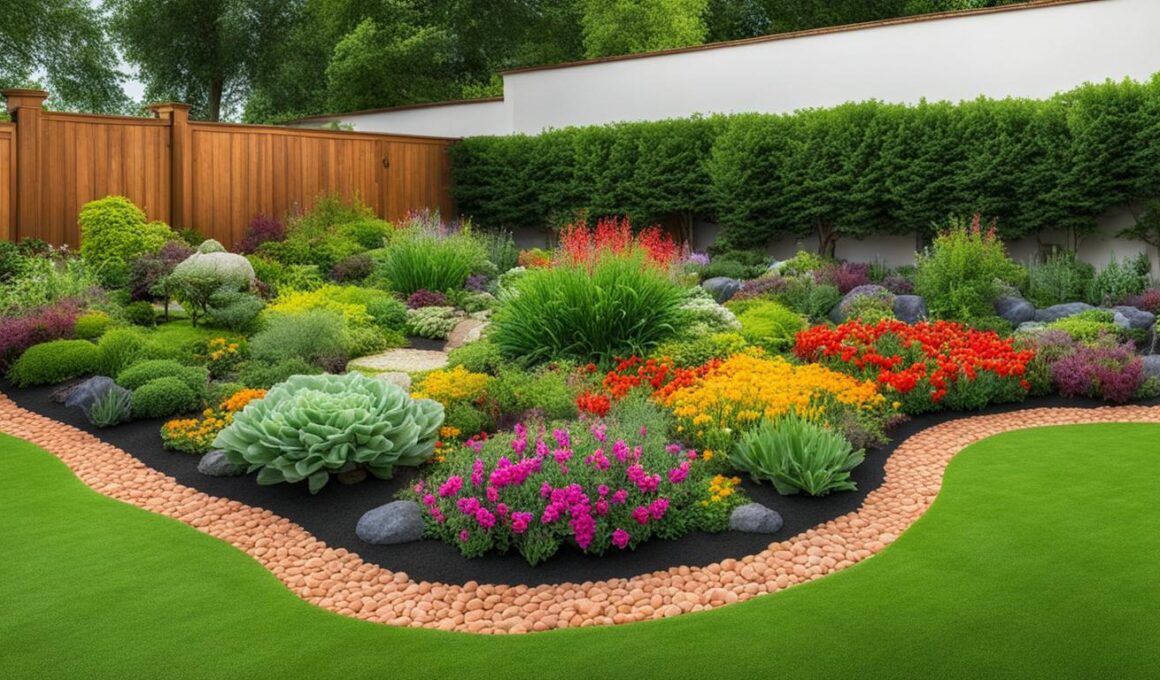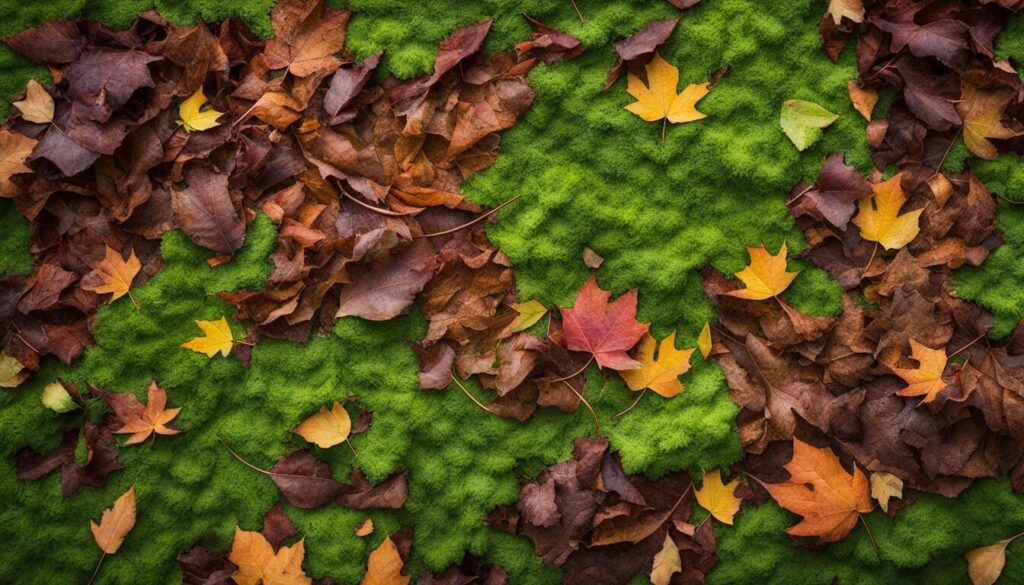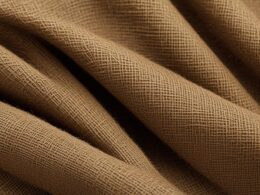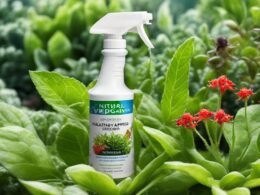Welcome to our article on eco-friendly landscape fabric alternatives. If you’re looking for cost-effective and sustainable options to control weeds in your garden or flowerbeds, you’ve come to the right place. We will explore 10 of the best landscape fabric alternatives that not only promote plant health and prevent soil erosion but also help you save money. So, let’s dive in and discover these eco-friendly alternatives!
Wood Chips
Wood chips are an excellent organic mulch alternative to landscape fabric. They slowly break down, providing nutrients to the soil, retain moisture, and regulate soil temperature.
Obtaining wood chips is easy as they can be found at local garden centers or tree care companies. These chips are typically made from trees and branches that have been chipped or shredded into small pieces.
When using wood chips as landscape fabric, it is best to apply a layer that is 2-3 inches deep. This depth allows for effective weed suppression and retains moisture in the soil. However, it’s important to keep the wood chips away from the trunks of trees and shrubs. Placing the chips directly against the trunks can lead to insect and disease problems.
Mulching with wood chips not only provides practical benefits but also adds a natural and rustic aesthetic to your garden. The decomposing chips create a rich and diverse ecosystem, attracting beneficial organisms like earthworms and fungi.
Bark Mulches
If you’re looking for an effective alternative to landscape fabric, bark mulches are a great option. Types such as cedar, pine, and hemlock offer numerous benefits for your garden. These mulches not only suppress weeds but also help retain moisture and add valuable nutrients to the soil. Additionally, they come in various textures, allowing you to choose the one that best suits your aesthetic preferences.
When applying bark mulches, it’s important to keep a few things in mind. Aim for a depth of 2-4 inches, ensuring that you don’t smother your plants by going too deep or using mulch particles that are too small. It’s also worth noting that bagged bark mulches are generally safer to use as they have undergone weathering to remove any potential toxins.
By opting for bark mulches as a landscape fabric alternative, you can create a weed-free and visually appealing garden while also nourishing your plants and promoting healthy growth.
Pine Needles
Looking for an eco-friendly and easily accessible alternative to landscape fabric? Look no further than pine needles! These natural wonders not only provide excellent weed control but also offer a range of benefits for your garden.
One of the key advantages of using pine needles as landscape fabric is their ability to retain moisture in the soil. They create a protective layer that minimizes evaporation, keeping your plants hydrated even during hot summer months.
Pine needles also act as a natural erosion control, preventing soil erosion and maintaining the integrity of your garden beds. Their interlocking nature helps to hold the soil in place, protecting it from heavy rainfall and runoff.
Another benefit of pine needles is their ability to add nitrogen to the soil as they break down. Nitrogen is an essential nutrient for plant growth, promoting healthy foliage and vibrant blooms.
Contrary to popular belief, pine needles do not acidify the soil. They have a slightly acidic pH, but this acidity is neutralized as they decompose. Therefore, you can freely use pine needles without worrying about altering the pH balance of your soil.
It’s worth noting that pine needles can be flammable, so they may not be suitable for areas prone to wildfires. Exercise caution when using pine needles in such regions and consider alternative options to minimize fire risks.
To use pine needles as landscape fabric, simply spread a layer of 2 to 3 inches around your vegetables, flowers, shrubs, or trees. This thickness provides effective weed suppression while allowing airflow and water penetration.
So, embrace the beauty and functionality of pine needles in your garden. Their natural qualities make them a sustainable choice that will benefit both your plants and the environment.
Shredded Leaves
Shredded leaves are an excellent eco-friendly alternative to landscape fabric in your garden. Not only do they serve as a natural weed barrier, but they also offer several other benefits for your plants and soil.
When you use shredded leaves as landscape fabric, they help minimize soil compaction and retain moisture, creating a healthier growing environment for your plants. By covering the soil with a layer of shredded leaves, you can also limit weed growth, reducing the need for manual weeding.
What’s more, shredded leaves gradually break down and enrich the soil with organic matter, improving its fertility. This organic matter provides essential nutrients to your plants, promoting their growth and overall health.
To prepare shredded leaves for use as landscape fabric, you can easily create them by running a lawn mower over fallen leaves or using a leaf vacuum mulcher. Once shredded, apply a layer of 3-4 inches around shrubs and trees, and 2-3 inches in flower and garden beds for optimal effectiveness.
Remember to spread the shredded leaves evenly to ensure consistent coverage and avoid piling them up against the stems or trunks of your plants. This will prevent possible rot and disease issues.
Using shredded leaves as landscape fabric is not only an eco-friendly option but also a cost-effective one. It’s a sustainable way to recycle and repurpose fallen leaves in your garden, while benefiting your plants and minimizing the need for synthetic materials.
So, next time you’re tempted to reach for landscape fabric, consider using shredded leaves instead. Your garden and the environment will thank you!
Benefits of Shredded Leaves as Landscape Fabric:
- Minimize soil compaction
- Retain moisture
- Limit weeds
- Add nutrients to the soil
- Eco-friendly and cost-effective
Grass Clippings
Looking for a natural and cost-effective alternative to landscape fabric? Look no further than your own backyard. Grass clippings can be a game-changer when it comes to mulching and weed control in your garden.
When you mow your lawn, rather than discarding the grass clippings, save them to use as a mulch and weed barrier. Grass clippings are not only abundant and readily available, but they are also packed with nutrients that can benefit your plants. By using them as a mulch, you can feed your garden while keeping weeds at bay.
How to use grass clippings as landscape fabric:
- Make sure the grass clippings are untreated with herbicides and not diseased. Using contaminated clippings can have negative effects on your plants.
- Apply a 1-inch layer of grass clippings around trees, shrubs, and gardens.
- Allow the grass clippings to dry out before adding more on top. This will prevent the layer from becoming too dense and generating foul odors.
- Tips: For best results, apply the clippings when they are dry to avoid clumping. It’s also a good idea to mix the clippings with other organic materials, such as shredded leaves or compost, to improve their texture and enhance their weed-suppressing properties.
By using grass clippings as landscape fabric, you can save money on mulch while creating a healthier and more sustainable garden environment. It’s a win-win!
Compost
Compost is an excellent alternative to landscape fabric that enhances soil health. By using compost in your garden, you can enjoy numerous benefits while promoting a sustainable and eco-friendly approach to gardening.
Compost retains moisture, keeping your plants hydrated and reducing the need for frequent watering. It acts as a natural barrier, blocking weed growth and minimizing the competition for nutrients and space in your garden. With compost, you can create a weed-free environment that allows your plants to thrive.
Moreover, compost provides a steady supply of nutrients to your plants, enriching the soil with essential elements for growth and development. It improves soil structure and fertility, resulting in healthier and more robust plants.
When using compost as a landscape fabric alternative, it’s important to note that only fully decomposed compost should be used. Avoid adding items like dairy products, meat, fatty food, or anything treated with chemicals, as they can disrupt the composting process and introduce harmful substances into your garden.
To apply compost in your garden, spread a layer of approximately 1 inch in flower beds and vegetable gardens. For trees and shrubs, it is recommended to apply a slightly thicker layer of 2 inches. However, be careful not to place the compost too close to the stems or trunks of plants, as this can cause rot and other problems.
As a key component of organic gardening, compost offers a natural and sustainable way to improve your garden’s soil and promote plant growth. Consider incorporating compost into your gardening practices and reap the benefits of using this eco-friendly landscape fabric alternative.
Newspaper and Cardboard
Looking for a biodegradable alternative to landscape fabric? Look no further than newspaper and cardboard. Not only are these readily available materials eco-friendly, but they also make excellent weed barriers for your garden.
To use newspaper or cardboard as landscape fabric alternatives, simply layer 4-8 sheets of newspaper or cardboard on the bare soil. Be sure to avoid using glossy or colored paper, as these may contain chemicals that can be harmful to the soil and plants. The layers of paper or cardboard will block sunlight, preventing weed growth.
After layering the newspaper or cardboard, lightly water the layers to help them settle and stay in place. This will create a barrier that suppresses weeds while allowing water and nutrients to reach the plants. To further enhance the effectiveness of the weed barrier, top the layers with a layer of mulch, such as grass clippings, compost, or shredded leaves.
This method of using newspaper and cardboard as landscape fabric alternatives is safe for use around trees, shrubs, flowers, and vegetables. It provides an effective and eco-friendly way to control weeds in your garden while reducing the use of synthetic materials.
Can Moss be used as an Eco-Friendly Alternative to Landscape Fabric?
Using moss as an eco-friendly alternative to landscape fabric presents an exciting option. With a growing moss timeline, green carpet-like coverage can be achieved, reducing the need for traditional, non-biodegradable materials. Moss can provide natural erosion control, moisture retention, and weed suppression, making it a sustainable choice for landscaping projects.
Conclusion
When it comes to weed control in your garden, there are plenty of eco-friendly alternatives to landscape fabric that are both effective and affordable. Wood chips, bark mulches, pine needles, shredded leaves, grass clippings, compost, newspaper, and cardboard can all serve as excellent weed barriers. Each alternative has its own unique benefits and considerations, allowing you to choose the best option for your specific gardening needs.
Wood chips are a great option around trees and shrubs, providing nutrients as they break down while retaining moisture. Bark mulches offer weed suppression and come in different textures to suit your preferences. Pine needles not only retain moisture but also add nitrogen to the soil, making them ideal for a variety of plants.
If you have an abundance of leaves, shredding them can create a natural weed barrier that also contributes valuable nutrients to the soil. Grass clippings can be composted or used directly as mulch, providing nutrients and preventing weed growth. Compost, on the other hand, enhances soil health, retains moisture, and offers steady nutrient supply. Lastly, newspaper and cardboard can be layered to effectively block weeds while decomposing over time.
By opting for these landscape fabric alternatives, you not only promote plant health but also practice eco-friendly gardening. These alternatives are sustainable, cost-effective, and help protect the planet. So, go ahead and nurture your garden using these natural weed barriers while contributing to a healthier and greener environment.











